Leek (genus)
| leek | ||||||||||||
|---|---|---|---|---|---|---|---|---|---|---|---|---|
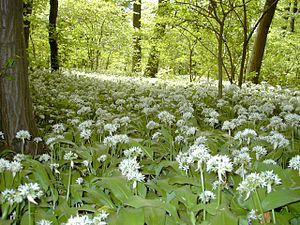
Flowering wild garlic ( Allium ursinum ) |
||||||||||||
| Systematics | ||||||||||||
|
||||||||||||
| Scientific name of the tribe | ||||||||||||
| Allieae | ||||||||||||
| Dumort. | ||||||||||||
| Scientific name of the genus | ||||||||||||
| Allium | ||||||||||||
| L. |
The genus leek ( Allium ) forms the only plant genus of the tribe Allieae , which belongs to the subfamily of Allioideae within the family of Amaryllis plants (Amaryllidaceae). Some species are known edible and aromatic plants, other species are used as ornamental plants. Allicin is responsible for the characteristic smell of most species , which is formed when plant parts are damaged by an enzyme from a sulfur-containing amino acid, alliin .
description













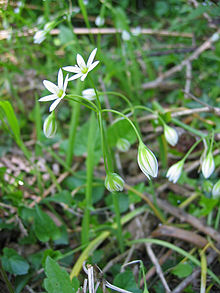



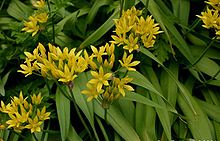






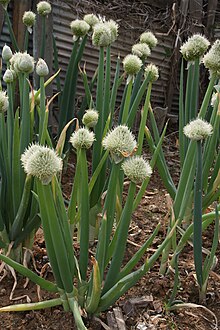

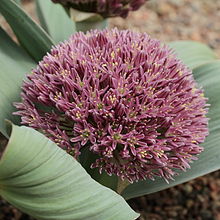








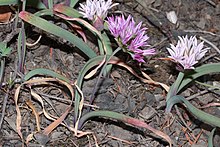
Vegetative characteristics
Allium species are perennial herbaceous plants that, depending on the species, have heights of growth of 5 to 200 centimeters. Often they form bulbs as persistence organs, some species also form rhizomes . Depending on the type, the onion casing can be smooth or divided into longitudinal fibers or strips, it can be reticulated or have mesh-like or hole-like structures. Most species have the typical onion smell.
The simple, parallel- veined leaves are mostly sessile. The leaf blades, which are 5 to 80 centimeters long, depending on the species, can be flat with a width of 0.3 to 15 centimeters or cylindrical with a diameter of less than 1 millimeter to over 2 centimeters, more rarely they are thread-shaped, triangular, semi-cylindrical or many thread-like Tip divided.
Generative characteristics
A more or less long, leafless inflorescence stem is formed. The umbellate inflorescences are sometimes almost spherical. Sometimes brood bulbs are formed in the inflorescences. There is often a large bract that protects the flowers when they are in bud.
The mostly hermaphrodite, mostly radial symmetry flowers are threefold. Few species form unisexual flowers and are then dioeciously separated ( dioecious ). The two by three bracts are identical in most species. The color of the bracts of the Allium species is often white, yellow, pink, blue, purple or red. There are two circles with three fertile stamens each. The three pistils have become a top permanent ovary grown.
There are fruit capsules formed. The black seeds are obovate to spherical.
Systematics and distribution
The genus Allium was first published in 1753 by Carl von Linné in Species Plantarum . Synonyms for Allium L. are: Caloscordum Herb. , Cepa Mill. , Milula Prain , Nectaroscordum Lindl.
The monophyletic genus Allium is the only genus of the tribe Allieae that belongs to the subfamily of the Allioideae within the family of the Amaryllis plants (Amaryllidaceae).
The genus Allium is according to N. Friesen, RM Fritsch & FR Blattner 2006 in 15 and Li et al. 2010 divided into 13 sub-genres with a total of about 72 sections . It includes around 940 species. The largest number of species is found in the Mediterranean , the Orient and from Turkestan to Tibet .
Here is a selection of the types:
- Subgenus Allium : There are 15 sections with about 305 species:
- Section Allium (species selection):
- Allium affine Ledeb. : The distribution area extends from Turkey to Lebanon and Iran .
- Allium amethystinum exchange (Syn .: Allium stojanovii Kov. ): The distribution area is the central and eastern Mediterranean area .
-
Field garlic ( Allium ampeloprasum L. , Syn. Allium babingtonii Borrer , Allium scorodoprasum var. Babingtonii (Borrer) Regel , Allium kurrat Schweinf. Ex K. Krause ): The distribution area extends from Macaronesia to the Mediterranean and Central Asia . The cultivar groups also belong here:
- Leek or leek ( Allium ampeloprasum leek group, Syn. Allium porrum L. , Allium ampeloprasum var. Porrum (L.) J.Gay )
- Pearl onion ( Allium ampeloprasum pearl onion group, Syn. Allium porrum var. Sectivum Lueder )
- Allium artemisietorum Eig & Feinbrun : The homeland ranges from Egypt and the Sinai Peninsula to Jordan .
- Allium ascalonicum L. (Syn .: Allium hierochuntinum Boiss. ). This species hasnothing to dowith the shallot !
- Black-violet leek ( Allium atroviolaceum Boiss. , Syn .: Allium ampeloprasum var. Atroviolaceum (Boiss.) Regel ): The distribution area extends from southern Central Europe to Central Asia.
- Allium aucheri Boiss. (Syn .: Allium caerulescens Boiss. ): The homeland ranges from eastern Turkey to Iran.
- Allium bourgeaui Rech.f. : The homeland stretches from southeastern Greece to southwestern Turkey.
- Edible onion ( Allium cepa L. ): purely cultivated plant, wild populations are not known.
- Allium commutatum cast. : It is common in the central and eastern Mediterranean .
- Allium curtum Boiss. & Gaill. : The distribution area extends from southern Turkey to Egypt.
- Allium dictyoprasum C.A.Mey. ex Kunth : The distribution area extends from eastern Turkey to northern Iran and northern Saudi Arabia.
- Allium dilatatum Zahar. : She is endemic to Crete .
- Allium ebusitanum Font Quer (Syn .: Allium durandoi (Batt. & Trab.) Seregin , Allium sphaerocephalon var. Durandoi Batt. & Trab. ): The homeland is Algeria, northern Tunisia and Ibiza .
- Allium fuscoviolaceum Fomin : The range extends from eastern Turkey to northwestern Iran.
- Allium gramineum K. Koch (Syn .: Allium fominianum Miscz. Ex Grossh. & Schischk. ): The distribution area extends from eastern Turkey to Transcaucasia.
- Allium guttatum Steven (Syn .: Allium dalmaticum A.Kern. Ex Janch. , Allium margaritaceum Sm. , Allium sardoum Moris ): The range extends from the Mediterranean area to southern Ukraine.
- Allium heldreichii Boiss. : The home is northern Greece.
- Allium iranicum (Wendelbo) Wendelbo : Home is Iran and northern Iraq.
- Allium jubatum J.F. Macbr. : The homeland is Bulgaria and northwestern Turkey.
- Allium kharputense Freyn & Sint. : The home area ranges from Turkey to Lebanon and northern Iraq.
- Allium leucanthum K. Koch : Home is Transcaucasia.
- Allium macrochaetum Boiss. & Hausskn. : The homeland is Turkey, Syria, northern Iraq and northwestern Iran.
- Allium melitense (Somm. & Caruana) Cif. & Giacom. (Syn .: Allium ampeloprasum var. Melitense Sommier & Caruana ex Borg. ): It is endemic to Malta .
- Allium polyanthum Schult. & Schult. f. : It occurs in the western and central Mediterranean area.
- Allium ponticum Miscz. ex Grossh. : It occurs from northeastern Turkey to Transcaucasia.
- Allium pseudoampeloprasum Miscz. ex Grossh. : It occurs from eastern Turkey to Transcaucasia.
- Allium pyrenaicum Costa & Vayr. : She is endemic to the Eastern Pyrenees.
- Round leek ( Allium rotundum L. , Syn .: Allium jajlae Vved. , Allium cilicium Boiss. , Allium waldsteinii G.Don ): The distribution area extends from Central Europe to northwestern Iran.
- Garlic ( Allium sativum L .; Syn .: Allium longicuspis rule ): The home is Central Asia to northeastern Iran.
- Snake leek or wild leek ( Allium scorodoprasum L. ): The range extends from Europe to the Caucasus and Israel.
- Ball-headed leek ( Allium sphaerocephalon L. , Syn .: Allium descendens L. ): This subheading includes five subspecies. The distribution area of the species extends from Europe, the Canary Islands and the Mediterranean area to the Caucasus.
- Allium truncatum (Feinbrun) Kollmann & Zohary (Syn .: Allium ampeloprasum var. Truncatum Feinbrun ): The home is the eastern Mediterranean area.
- Allium tuncelianum (Kollmann) Özhatay et al. : The homeland is eastern Turkey.
- Vineyard leek ( Allium vineale L. , Syn .: Allium kochii Lange , Allium vineale var. Purpureum H.PGKoch ): The range includes Europe and the Mediterranean area to northern Iran.
- Section Avulsea F.O.Khass.
- Allium rubellum M.Bieb. (Syn .: Allium albanum Grossh. ): The distribution area extends from Turkey to Central Asia.
- Allium umbilicatum Boiss. : The range extends from Central Asia to western Pakistan.
- Section Brevidentia F.O.Khass. et Iengalycheva
- Allium brevidens Vved. : It occurs in two subspecies in Central Asia.
- Brevispatha Valsecchi section
- Allium lojaconoi Brullo, Lanfr. & P.Pavone : She is endemic to Malta.
- Section Caerulea (Omelcz.) FOKhass.
- Lilac leek, blue ball leek ( Allium caeruleum Pall. , Syn .: Allium azureum Ledeb. , Allium viviparum Kar. & Kir. ): The distribution area extends from Eastern Europe to northwestern China.
- Allium cesium Schrenk (Syn .: Allium urceolatum rule ): The range extends from Central Asia to northwestern China.
- Allium delicatulum Siev. ex Schult. & Schult. f. : The distribution area extends from Eastern Europe to northwestern China.
- Section Codonoprasum Reichenb.
- Kiel leek or keeled leek ( Allium carinatum L. , Syn .: Allium pulchellum G.Don ): The species occurs in two subspecies from Europe to northern Turkey.
- Allium chloranthum Boiss. : The home is southern Turkey.
- Allium desertorum Forssk. : It occurs in Egypt, on the Sinai Peninsula and in Palestine.
- Yellow leek or yellow leek ( Allium flavum L. , Syn .: Allium paczoskianum Tuzson ): It occurs in three subspecies and two varieties from southern and central Europe to western Turkey.
- Allium kunthianum Vved. (Syn .: Allium lepidum Kunth ): The distribution area ranges from northeastern Turkey to northwestern Iran.
- Allium melanantherum Pančić : The range includes Bulgaria, Macedonia, northern Greece and Serbia.
- Cabbage leek or horse leek, vegetable leek ( Allium oleraceum L. ): The range extends from Europe to the Caucasus.
- Allium pallens L. (Syn .: Allium coppoleri Tineo ): The distribution area extends from the Mediterranean region to Iran.
- Allium paniculatum L. (Syn .: Allium karsianum Fomin ): It occurs in two subspecies from southern Europe to the Caucasus.
- Allium parnassicum (Boiss.) Halacsy : The home is southern Greece.
- Allium platakisii Tzanoud. & Kypr. : She is endemic to Crete.
- Allium pseudoflavum Vved. : It occurs from Turkey to northern Iran.
- Allium rupestre Steven (Syn .: Allium charaulicum Fomin ): It occurs from Bulgaria to the Crimea and from northern Turkey to the Caucasus.
- Allium stamineum Boiss. : It occurs from Turkey to Iran and to Saudi Arabia.
- Section Costulata F.O.Khass. & Yengal.
- Allium filidens rule : It occurs in three subspecies from Central Asia to Pakistan.
- Allium turcomanicum rule : It occurs from Central Asia to northeastern Iran and Afghanistan.
- Section Crystallina F.O.Khass. & Iengalycheva
- Allium crystallinum Vved. : The home is Central Asia.
- Section Eremoprasum (Kamelin) FOKhass. ex RMFritsch & N. Friesen
- Allium sabulosum Steven ex Bunge : It occurs from Iran to northwestern China.
- Section Kopetdagia F.O.Khass.
- Allium kopetdagense Vved. : It occurs from northeastern Iran to southern Turkmenistan.
- Section Longivaginata (camelina) FOKhass. ex RMFritsch & N. Friesen
- Allium longivaginatum Wendelbo : Home is Iran.
- Section Mediasia F.O.Khass., Yengalycheva & N. Friesen
- Allium turkestanicum rule : Home is Central Asia.
- Section Multicaulea F.O.Khass. & Iengalycheva
- Allium lehmannianum Merckl. ex Bunge : The home is Central Asia.
- Section Pallasia (Tzag.) FOKhass. ex RMFritsch & N. Friesen
- Allium pallasii Murray : It occurs from Siberia to Central Asia.
- Allium tanguticum rule : It occurs in Qinghai, China and Tibet.
- Section Spathulata F.O.Khass. & RMFritsch
- Allium spathulatum Khass. & RMFritsch : The home is Central Asia.
- Section Allium (species selection):
- Subgenus Amerallium Traub : It contains twelve sections:
- Section Amerallium ( grape ) Kamelin : Only in the Neotropic :
- Indian garlic ( Allium canadense L. , Syn .: Allium mutabile Michx. )
- Allium drummondii rule (Syn .: Allium nuttallii S. Watson )
- Allium geyeri S. Watson (including Allium fibrosum rule )
- Section Arctoprasum Kirschl. :
- Wild garlic ( Allium ursinum L. )
- Briseis Section (Salesb.) Stearn :
- Wonder leek , strange leek ( Allium paradoxum (M.Bieb.) G.Don )
- Bell leek ( Allium triquetrum L. )
- Section Bromatorrhiza Ekberg :
- Allium hookeri Thwaites
- Allium macranthum Baker (Syn .: Allium oviflorum rule )
- Hanging leek ( Allium pendulinum Ten. )
- Allium wallichii Kunth (Syn .: Allium polyastrum Diels , Allium wallichianum Steud. Nom. Nud.)
- Section Caulorhizideum Traub :
- Allium validum S. Watson
- Section Chamaeprason Hermann :
- Allium brevistylum S. Watson
- Allium gooddingii Ownbey
- Allium chamaemoly L.
- Section Lophioprasone Traub : It occurs only in North America, mainly in California, but hardly east of the Rocky Mountains:
- Allium acuminatum Hook.
- Allium amplectens Torr. (Syn .: Allium attenuifolium Kellogg )
- Allium bigelovii S. Watson
- Allium campanulatum S.Watson (Syn .: Allium bidwelliae S.Watson )
- Allium cernuum Roth
- Allium crispum Greene
- Allium falcifolium Hook. & Arn.
- Allium fimbriatum S. Watson
- Allium lemmonii S. Watson
- Allium munzii (Ownbey & Aase ex Traub) McNeal
- Allium praecox Brandegee
- Allium siskiyouense Ownbey ex grape
- Allium stellatum Ker Gawl.
- Allium unifolium Kellogg
- Section Molium G. Don ex Koch :
- Gold leek ( Allium moly L. )
- Neapolitan leek ( Allium neapolitanum Cirillo )
- Rose leek ( Allium roseum L. )
- Ciliate leek ( Allium subhirsutum L. , Syn .: Allium ciliatum Cirillo )
- Allium zebdanense Boiss. & Noë
- Section Narkissoprason Hermann :
- Southern Alps leek ( Allium insubricum Boiss. & Reut. )
- Daffodil-flowered leek ( Allium narcissiflorum Vill. , Syn .: Allium pedemontanum Willd. )
- Section Rhophetoprason Traub :
- Allium glandulosum Link & Otto : It is distributed from Mexico to Central America.
- Section Rhynchocarpum Brullo :
- Allium Ruhmerianum Aschers.
- Section Triptera Kamelin et Seisums :
- Allium tripterum Nasir
- Section Amerallium ( grape ) Kamelin : Only in the Neotropic :
- Subgenus Anguinum (G.Don ex Koch) N. Friesen : There is only one section:
- Section Anguinum G.Don :
- Allium tricoccum Aiton (Syn .: Allium burdickii (Hanes) AGJones)
- Allermann's harness ( Allium victorialis L. )
- Section Anguinum G.Don :
- Subgenus Butomissa (Salisb.) N. Friesen : It contains two sections:
- Section Austro Montana N.Friesen :
- Allium oreoprasum Schrenk
- Section Butomissa (Salisb.) Kamelin :
- Scented leek or Chinese leek ( Allium ramosum L., Syn .: Allium odorum L., Allium tataricum L. f. , Allium lancipetalum YPHsu, Allium potaninii rule , Allium soft anicum Palibin.)
- Garlic-Chives ( Allium tuberosum Rottler ex Spreng.)
- Section Austro Montana N.Friesen :
- Subgenus Caloscordum (Herb.) RMFritsch : There is only one section:
- Section Caloscordum (Herb.) Bak.
- Allium tubiflorum Rendle
- Section Caloscordum (Herb.) Bak.
- Subgenus Cepa (Mill.) Radić : It contains five sections:
- Section Annuloprason T.V.Egorova :
- Allium atrosanguineum Schrenk (including Allium fedschenkoanum rule; Allium kaufmannii rule)
- Allium semenovii rule
- Section Cepa (Mill.) Prokh. :
- Allium altaicum Pall.
- Allium asarense RMFritsch & Matin
- Kitchen onion ( Allium cepa L. ). The shallot also belongs here .
- Allium × cornutum Clementi
- Allium farctum Wendelbo
- Winter onion ( Allium fistulosum L. )
- Allium galanthum Kar. & Kir. (Syn .: Allium pseudocepa Schrenk)
- Allium oschaninii O.Fedtsch.
- Allium premixtum Vved.
- Allium × proliferum (Moench) Schrad. ex Willd. (= Allium fistulosum × Allium cepa , Syn .: Allium cepa var. Bulbiferum Regel, Allium cepa var. Proliferum (Moench) Alef., Allium cepa var. Viviparum (Metzg.) Alef., Allium cepa viviparum Metzg., Allium × wakegii Araki)
- Allium pskemense B. Fedsch.
- Allium rhabdotum Stearn
- Allium vavilovii Popov & Vved.
- Section Condensata N. Friesen
- Allium condensatum Turcz.
- Section Sacculifera P.P. Gritz. :
- Allium chinense G.Don (Syn .: Allium bakeri rule)
- Allium sacculiferum Maxim.
- Allium thunbergii G.Don (Syn .: Allium taquetii H.Lév.)
- Allium virgunculae F. Maek . & Kitam.
- Section Schoenoprasum Dum. :
- Allium altyncolicum N.Friesen
- Allium karelinii Polyakov (Syn .: Allium schoenoprasum var. Scaberrimum rule)
- Allium ledebourianum Schult. & Schult. f.
- Allium maximowiczii rule
- Allium oliganthum Kar. & Kir. (Syn .: Allium stenophyllum Schrenk )
- Allium schmitzii Cout.
-
Chives ( Allium schoenoprasum L.) closed circumpolar spread, with three subspecies:
- subsp. schoenoprasum (with 4 informal morphological types)
- subsp. latiorifolium (Pau) Rivas Marinez et al. (Polyploid species, reticulate evolution through intersectional introgression)
- subsp. orosiae Montserrat
- Section Annuloprason T.V.Egorova :
- Subgenus Cyathophora (RMFritsch) RMFritsch : It contains three sections:
- Section Coleoblastus Ekberg :
- Allium auriculatum Kunth
- Allium mairei H.Lév. (Syn .: Allium yunnanense Diels)
- Section Cyathophora R.M.Fritsch :
- Allium cyathophorum Bureau & Franch.
- Section Milula (Prain) Frisians :
- Allium spicatum (Prain) N. Friesen
- Section Coleoblastus Ekberg :
- Subgenus Melanocrommyum (Webb & Berth.) Rouy : It contains about 20 sections with up to 160 species:
- Acanthoprason Wendelbo Section :
- Allium akaka SGGmel. ex Schult. & Schult. f.
- Allium libani Boiss.
- Allium materculae Bordz.
- Section Acaule R.M.Fritsch :
- Allium hexaceras Vved.
- Section Acmopetala R.M.Fritsch :
- Allium costatovaginatum Kamelin & Levichev
- Allium fetisowii rule
- Allium saposhnikovii Nikitina (Syn .: Allium collis-magni Kamelin)
- Allium sewerzowii rule
- Allium suworowii rule
- Allium taeniopetalum Popov & Vved. (Syn .: Allium baschkyzylsaicum Krassovsk., Allium mogoltavicum Vved.)
- Allium tschimganicum B. Fedsch. (Syn .: Allium motor Kamelin & Levichev)
- Section Aroidea Khass. & RMFritsch :
- Allium aroides Vved. et Popov
- Section Brevicaule R.M. Fritsch :
- Allium sergii Vved.
- Section Compactoprason R.M.Fritsch :
- Giant leek ( Allium giganteum rule )
- Allium macleanii Baker (Syn .: Allium elatum rule )
- Section Kaloprason C. Koch :
- Star ball leek ( Allium cristophii Trautv., Syn .: Allium albopilosum CHWright, Allium walteri Regel , Allium bodeanum Regel , Allium christophii Trautv. Orth. Var.)
- Allium helicophyllum Vved.
- Allium schubertii Zucc.
- Section Megaloprason Wendelbo :
- Allium aflatunense B. Fedsch.
- Allium altissimum rule
- Allium grande Lipsky
- Allium jesdianum Boiss. & Buhse
- Allium rosenbachianum rule
- Allium stipitatum rule
- Section Melanocrommyum Webb & Berth. :
- Allium ashersonianum Barbey
- Allium asclepiadeum Bornm.
- Black and red leek or purple leek ( Allium atropurpureum Waldst. & Kit.)
- Allium cyrilli Ten.
- Allium decipiens fish. ex Schult. & Schult. f.
- Black leek or black leek ( Allium nigrum L. , Syn .: Allium dumetorum Feinbrun & Szel., Allium multibulbosum Jacq.)
- Allium orientale Boiss.
- Allium rothii Zucc.
- Allium stenopetalum Boiss. & Kotschy
- Allium tel-avivense Eig
- Allium tubergenii Freyn
- Allium tulipifolium Ledeb.
- Section Miniprason R.M.Fritsch :
- Bluetongue leek ( Allium karataviense rule)
- Section Popovia Khass. & RMFritsch :
- Allium gypsaceum Popov et Vved.
- Section Pseudoprason (Wendelbo) K. Persson & Wendelbo :
- Allium cardiostemon fish. & CAMey.
- Allium koelzii (Wendelbo) K. Perss. et Wendelbo
- Allium mariae Bordz.
- Section Regeloprason Wendelbo :
- Allium darwasicum rule : It occurs in Uzbekistan and in the southern Pamirs and Altai .
- Allium Regelii Trautv.
- Allium winklerianum rule
- Section Thaumasioprason Wendelbo :
- Allium mirum Wendelbo
- Section Verticillata Kamelin :
- Allium verticillatum rule
- Acanthoprason Wendelbo Section :
- Subgenus Microscordum (Maxim.) N. Friesen : There is only one section; it occurs only in East Asia:
- Microscordum Maxim section . : There is only one type:
- Allium monanthum Maxim.
- Microscordum Maxim section . : There is only one type:
- Subgenus Nectaroscordum (Lindl.) Asch. et Graebn. : There is only one section:
- Section Nectaroscordum (Lindl.) Gren. & Godr. :
- Allium bulgaricum (Janka) Prodán (Syn .: Allium dioscoridis auct., Nectaroscordum bulgaricum Janka, Nectaroscordum siculum subsp. Bulgaricum (Janka) Stearn): Also called a subspecies subsp. dioscoridis (Sm.) K. Richt. to Allium siculum .
- Sicilian honey leek ( Allium siculum Ucria, Syn .: Nectaroscordum siculum (Ucria) Lindl.)
- Section Nectaroscordum (Lindl.) Gren. & Godr. :
- Subgenus Polyprason Radić : It contains four sections:
- Section Daghestanica (Tscholok.) N. Friesen :
- Allium chrysanthum rule
- Allium chrysocephalum rule
- Allium daghestanicum Grossh.
- Allium ericetorum Thore (Syn .: Allium ochroleucum Waldst. & Kit. )
- Allium herderianum rule
- Allium maowenense J.M.Xu
- Allium rude J.M.Xu
- Fragrant leek ( Allium suaveolens Jacq. )
- Allium xichuanense J.M.Xu
- Section Falcatifolia N. Friesen :
- Allium blandum Wall. (synonym of Allium carolinianum for some authors)
- Allium carolinianum DC. (Syn .: Allium polyphyllum Kar. & Kir. , Allium thomsonii Baker , Allium obtusifolium Klotzsch , Allium platyspathum var. Falcatum rule , Allium aitchisonii Boiss. Nom. Illeg., Allium platystylum rule ): It is widespread from Central Asia to the Himalayas.
- Allium hymenorrhizum Ledeb.
- Allium kaschianum rule
- Allium phariense Rendle (insecure position): It is distributed from Bhutan to northwestern Sichuan.
- Allium platyspathum Schrenk
- Section Oreiprason F. Herm. :
- Allium albovianum Vved. (Syn .: Allium gracile Albov )
- Allium caricoides rule (some authors synonymous with Allium kokanicum rule )
- Allium consanguineum Kunth
- Allium glaciale Vved.
- Allium goloskokovii Vved.
- Allium horvatii Lovrić
- Allium kaschianum rule
- Allium kokanicum rule
- Allium kurssanovii Popov
- Allium megalobulbon rule : It occurs only in western Xinjiang.
- Yellow leek ( Allium obliquum L. )
- Allium petraeum Kar. & Kir.
- Allium pevtzovii Prokh. ?
- Allium roylei Stearn
- Allium saxatile M.Bieb. (Syn .: Allium globosum M.Bieb. Ex DC. )
- Allium setifolium Schrenk
- Allium stracheyi Baker
- Allium subtilissimum Ledeb.
- Allium talassicum rule
- Allium tianschanicum Rupr. (Syn .: Allium hymenorhizum . Var tianschanicum . (Rupr) rule , Allium MacroRhizon rule , Allium globosum var. Albidum rule ): It is spread from Central Asia to northwestern China.
- Section Scorodon Koch sensu strictissimo :
- Allium frigidum Boiss. & Hero.
- Allium jacquemontii Kunth
- Allium macrostemon Bunge (Syn .: Allium grayi rule , Allium nipponicum Franch. & Sav.)
- Allium moschatum L.
- Allium popovii Vved.
- Section Daghestanica (Tscholok.) N. Friesen :
- Subgenus Porphyroprason (Ekberg) RMFritsch : There is only one section:
- Section Porphyroprason Ekberg :
- Red ornamental leek ( Allium oreophilum CAMey., Syn .: Allium ostrowskianum rule)
- Section Porphyroprason Ekberg :
- Subgenus Reticulatobulbosa (Kamelin) N. Friesen : It contains five sections:
- Section Campanulata Kamelin :
- Allium barsczewskii Lipsky
- Allium drepanophyllum Vved.
- Allium inconspicuum Vved.
- Allium jodanthum Vved.
- Section Nigrimontana N.Friesen :
- Allium drobovii Vved.
- Section Reticulatobulbosa Camelin :
- Allium amphibolum Ledeb.
- Allium clathratum Ledeb.
- Allium eriocoleum Vved.
- Allium flavidum Ledeb.
- Allium flavovirens rule (Syn .: Allium leucocephalum Turcz. Ex Vved., Allium schischkinii K.Sobol.)
- Allium linear L.
- Allium pseudostrictum Albov
- Allium splendens Willd.
- Stiff leek or stiff leek ( Allium strictum Schrad.)
- Allium szovitsii rule
- Section Scabriscapa (Tscholok.) N. Friesen :
- Allium scabriscapum Boiss. & Kotschy
- Section Sikkimensia N. Friesen :
- Allium aciphyllum J.M.Xu
- Allium beesianum W.W.Sm.
- Allium changduense J.M.Xu
- Allium cyaneum rule
- Allium forrestii Diels
- Allium henryi C.H. Wright
- Allium heteronema F.T.Wang & Tang
- Allium paepalanthoides Airy Shaw
- Allium plurifoliatum Rendle
- Allium sikkimense Baker (Syn .: Allium kansuense rule , Allium tibeticum Rendle )
- Allium stenodon Nakai & Kitag.
- Allium yuanum F.T.Wang & Tang
- Section Campanulata Kamelin :
- Subgenus Rhizirideum (G.Don ex Koch) Wendelbo sensu strictissimo: It contains five sections:
- Section Caespitosoprason N.Friesen :
- Allium bidentatum fish. ex Prokh.
- Allium mongolicum rule
- Allium polyrhizum Turcz. ex rule
- Allium przewalskianum rule
- Allium subangulatum rule
- Section Eduardia N. Friesen :
- Allium eduardii Stearn
- Section Rhizirideum G.Don ex Koch sensu stricto:
- Allium albidum fish. ex M.Bieb.
- Edge leek ( Allium angulosum L. )
- Allium austrosibiricum N. Friesen
- Allium burjaticum N.Friesen
- Allium denudatum Redouté (Syn .: Allium albidum Fisch. Ex M.Bieb.)
- Mountain leek ( Allium lusitanicum Lam., Syn .: Allium fallax Schult. & Schult. F., Allium montanum FWSchmidt)
- Allium nutans L.
- Allium prostratum Trevir.
- Allium rubens Schrad. ex Willd.
- Allium senescens L. (Syn .: Allium baicalense Willd., Syn .: Allium glaucum Schrad. Ex Poir.)
- Allium spiral Willd.
- Allium spurium G.Don (Syn .: Allium dauricum N. Friesen, Allium saxicola Kitag.)
- Allium stellerianum Willd.
- Section Rhizomatosa Egor. :
- Allium caespitosum Siev.
- Section Tenuissima (Tzag.) Deals :
- Allium anisopodium Ledeb.
- Allium tenuissimum L.
- Allium vodopjanovae N.Friesen
- Section Caespitosoprason N.Friesen :
- Subgenus Vvedenskya (camelina) RMFritsch : There is only one section:
- Section Vvedenskya Kamelin :
- Allium kujukense Vved.
- Section Vvedenskya Kamelin :
use
The following frequently cultivated species are used as food: onions ( Allium cepa ), winter onions ( Allium fistulosum ), garlic ( Allium sativum ), shallots ( Allium ascalonicum ), chives ( Allium schoenoprasum ), leeks ( Allium ampeloprasum ). Wild garlic ( Allium ursinum ) and wonder garlic ( Allium paradoxum ) grow wild, but nowadays also often used in the kitchen .
The genus was chosen by the Association for the Preservation of Crop Diversity eV (VEN) as " Vegetable of the Year " 2013/2014 in Germany.
Many species and varieties of the genus Allium are used as ornamental plants . One example is the star ball leek ( Allium cristophii ).
Cultural history
The ancestors of the cultivated leek species are mostly native to inner Asia , but were spread as a coarse spice in the distant past. The Egyptians even regarded the leeks as sacred and consecrated and were therefore not touched by priests and pious people.
swell
literature
- Dale W. McNeal Jr., TD Jacobsen: Allium. In: Flora of North America Editorial Committee (Ed.): Flora of North America North of Mexico . Volume 26: Magnoliophyta: Liliidae: Liliales and Orchidales . Oxford University Press, New York / Oxford a. a. 2002, ISBN 0-19-515208-5 , pp. 224 ff . (English, online at efloras.org ). (Sections Description and Distribution).
- Xu Jiemei, Rudolf V. Kamelin: Allium. In: Wu Zheng-yi, Peter H. Raven (Ed.): Flora of China . Volume 24: Flagellariaceae through Marantaceae . Science Press / Missouri Botanical Garden Press, Beijing / St. Louis 2000, ISBN 0-915279-83-5 , pp. 165–202 (English, online at efloras.org - http://flora.huh.harvard.edu/china/PDF/PDF24/allium.pdf PDF file). (Sections Description and Distribution).
- Nikolai Friesen, Reinhard M. Fritsch, Frank R. Blattner: Phylogeny and new intrageneric classification of Allium (Alliaceae) based on nuclear rDNA ITS sequences. In: JT Columbus, EA Friar, CW Hamilton, JM Porter, LM Prince, MG Simpson (eds.): Monocots: Comparative Biology and Evolution I. In: Aliso. Volume 22, 2006, pp. 372–395, (PDF file; 3.6 MB) (Systematic section: Classification into sub- genres and sections).
- Reinhard M. Fritsch: New results on the taxonomy and evolution of Allium L. In: Reinhard M. Fritsch, K. Hammer (Hrsg.): Evolution and taxonomy of plant-genetic resources: Festschrift for Peter Hanelt. In: Writings on Genetic Resources. Volume 4, pp. 19-46. Information Center for Genetic Resources, Bonn 1996 (PDF file; 6.6 MB).
- Jan Kusterer: New insights into sulfur chemistry and chemotaxonomy in species of the genus Allium. Dissertation from the Philipps University of Marburg, 2010, PDF file.
- Nikolai Friesen: The genus Allium - taxonomic overview and scientific collection in the Botanical Garden of the University of Osnabrück , In: Osnabrücker Naturwissenschaftliche Mitteilungen. Volume 33/34, 2008, pp. 95-110, PDF file.
- Kurt Heyer: The allium species as a medicine in the use of occidental medicine. In: Kyklos. Volume 1, 1928, pp. 64-102.
- Qin-Qin Li, Song-Dong Zhou, Xing-Jin He, Yan Yu, Yu-Cheng Zhang, Xian-Qin Wei: Phylogeny and biogeography of Allium (Amaryllidaceae: Allieae) based on nuclear ribosomal internal transcribed spacer and chloroplast rps16 sequences, focusing on the inclusion of species endemic to China. In: Annals of Botany , Volume 106, Issue 5, 2010, pp. 709-733. doi : 10.1093 / aob / mcq177 , PMC 2958792 (free full text)
- Siegmund Seybold : Flora of Germany and neighboring countries. A book for identifying vascular plants that grow wild and often cultivated . Founded by Otto Schmeil , Jost Fitschen . 93rd completely revised and expanded edition. Quelle & Meyer, Wiebelsheim 2006, ISBN 3-494-01413-2 .
Individual evidence
- ↑ Carl von Linné: Species Plantarum. Volume 1, Lars Salvius, Stockholm 1753, p. 294, digitized
- ^ A b c d Allium in the Germplasm Resources Information Network (GRIN), USDA , ARS , National Genetic Resources Program. National Germplasm Resources Laboratory, Beltsville, Maryland.
- ↑ a b c d e f g h i j k l m n o p q r s t u v w x y z aa ab ac ad ae af ag ah ai aj ak al am an ao ap aq ar as at au av aw ax ay az ba bb bc bd be bf bg bh bi bj bk bl bm bn bo bp bq br bs Rafaël Govaerts (Ed.): Allium - data sheet at World Checklist of Selected Plant Families of the Board of Trustees of the Royal Botanic Gardens, Kew . Last accessed on September 22, 2016.
- ↑ Pablo Hirschegger, Jernej Jaške, Peter Trontelj, Borut Bohanec: Origins of Allium ampeloprasum horticultural groups and a molecular phylogeny of the section Allium (Allium; Alliaceae). In: Molecular Phylogenetics and Evolution. Volume 54, No. 2, 2010, pp. 488-497, doi : 10.1016 / j.ympev.2009.08.030 .
- ^ Brian Mathew: A review of Allium sect. Allium . The Royal Botanic Gardens, Kew 1996, ISBN 0-947643-93-1 .
- ↑ Nikolai Friesen 1996: A taxonomic and chorological revision of the section Schoenoprasum Dumort. (GenusAllium L.). Candollea. 51: 461-473.
- ↑ Nikolai Friesen 1996: p. 469
- ↑ Nikolai Friesen & FR Blattner 2000: RAPD Analysis Reveals Geographic Differentiation within Allium schoenoprasum L. (Alliceae). Plant Biology, 2000, Vol. 2/3, 297-305
- ↑ Reinhard M. Fritsch, Frank R. Blattner, Maia Gurushidze: New Classification of Allium L. subg. Melanocrommyum (Webb & Berthel.) Rouy (Alliaceae) Based on Molecular and Morphological Characters. In: Phyton, Annales Rei Botanicae, Horn. Volume 49, No. 2, 2010, ISSN 0079-2047 , pp. 145-220, abstract. ( Page no longer available , search in web archives ) Info: The link was automatically marked as defective. Please check the link according to the instructions and then remove this notice.
- ↑ Maia Gurushidze, Reinhard M. Fritsch, Frank R. Blattner: Species level phylogeny of Allium subgenus Melanocrommyum - incomplete lineage sorting, hybridization and trnF gene duplication. In: Taxon. Volume 59, No. 3, 2010, pp. 829-840, abstract.
- ↑ a b c d e f g h i j k l m n o p q r s t u v w x y z aa ab ac ad ae Nikolai Friesen, Reinhard M. Fritsch, Frank R. Blattner: Phylogeny and new intrageneric classification of Allium (Alliaceae) based on nuclear rDNA ITS sequences. In: JT Columbus, EA Friar, CW Hamilton, JM Porter, LM Prince, MG Simpson (eds.): Monocots: Comparative Biology and Evolution I. In: Aliso. Volume 22, 2006, pp. 372–395, (PDF file; 3.6 MB) ( Memento of the original from February 26, 2013 in the Internet Archive ) Info: The archive link has been inserted automatically and has not yet been checked. Please check the original and archive link according to the instructions and then remove this notice.
- ↑ a b c d e f g h i j k l m n o p q r s t u v w x y z aa ab ac ad ae Qin-Qin Li, Song-Dong Zhou, Xing-Jin He, Yan Yu, Yu-Cheng Zhang, Xian-Qin Wei: Phylogeny and biogeography of Allium (Amaryllidaceae: Allieae) based on nuclear ribosomal internal transcribed spacer and chloroplast rps16 sequences, focusing on the inclusion of species endemic to China. In: Annals of Botany , Volume 106, Issue 5, 2010, pp. 709-733. doi : 10.1093 / aob / mcq177 , PMC 2958792 (free full text).
- ↑ AP Seregin, B. Anačkov, Nikolai Friesen: Molecular and morphological revision of the Allium saxatile Group (Amaryllidaceae): geographical isolation as the driving force of speciation underestimated. In: Botan. Jour. Linn. Soc. , Volume 178, 2015, pp. 67–101 (PDF)



